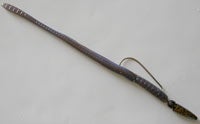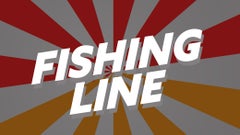Texas Rig
Probably the most common method of rigging a plastic bait and the most familiar to fishermen is the Texas Rig. It is a quick and simple technique to fish one of the most productive bass lures; the plastic worm. In the original Texas Rig, the worm is rigged on the hook with the point of the hook pinned back into the body of the worm to make it weedless and a bullet weight is used on the line ahead of the hook. In recent years the term Texas Rig has come to mean the weedless method of putting the bait on the hook whether a weight is used or not. Thus, many anglers talk about Texas Rigging a Senko or other soft plastic stick baits, or Texas Rigging their drop shot bait on an offset hook to enable them to fish the drop shot around wood and other hook-snagging cover.
Every angler you talk to will have some variation of the basic Texas Rig and the description given here is certainly not the final word on this versatile technique. Everyone has their own favorite hook; straight shank, offset shank, round bend, O'Shaugnessy bend, Kahle bend, extra wide gap, and on and on. Which ever hook you prefer, the final product should offer the point of the hook stuck back into the body of the worm and the worm itself having a straight profile when laid on a flat surface or suspended in the water. If the worm has a big hump or bulge where the point is inserted or 'bunches up' on the front of the hook, it will not look like a natural presentation to a bass. If this happens, it will probably lessen the number of bites you'll get and will also increase line twist since the worm will tend to spin when retrieved. Neither of these are good scenarios. These days the preferred hook by most anglers is an offset shank, O'Shaugnessy bend, wide gap round bend, or extra wide gap hook. The common feature is the offset shank.

The selection of the size of the hook should be determined by the size of the worm; the bigger the worm, the bigger the hook. Often the plastic bait being used is not a plastic worm but something thicker like a Brush Hog or other large creature bait, a Senko, Fat Ika, or other flip bait that is thick and heavy and requires a very large hook. The other criteria when selecting the hook is the weight of the line used. Heavy lines require heavy wire hooks since light wire hooks will straighten out before the line snaps, taking away the advantage of the strong line. Tackle Warehouse offers the two best hooks on the market today; Gamakatsu and Owner. Both of these manufacturers offer different gauges of wire in several models of hooks to accommodate the weight of the line used, even up to the super braid lines like Spider Wire and Power Pro. To determine the size hook that will be appropriate for each type of bait place the bait flat along the shank of the hook and see how much space there is between the back of the bait and the point of the hook. If it doesn't look like there is enough gap, use a bigger hook or go to an extra wide gap style. If the hook seems to overpower the bait you're using, downsize.

To start the Texas Rig, determine whether or not you will be using a weight, the type of weight, if you will peg the weight, and if you will be using a glass bead for more sound on the rig. First, insert the point of the hook into the front, or 'nose, of the worm. If you will be using a sliding weight and a glass bead, such as the Top Brass Brass n' Glass, push the point in only about 1/8 inch and circle it down and out the 'belly' of the bait (the flat side on a hand-poured worm) and slide the worm up the shank of the hook and onto the offset portion. If you will be pegging the weight or using no weight, push the point further into the nose of the worm before exiting the belly. Hold the worm against the point of the hook to measure where the point will exit and just slightly further down the belly of the bait push the point in, angling toward the nose. If you've measured right the point will just exit the back of the bait without stretching the worm or creating a bend in the worm between the point and the eye. There are a variety of methods for making sure the point is not exposed. One method is to slide the point back into the worm and push it forward inside the worm just under the 'skin'. When the fish bites and you set the hook it should be easy for the point to exit and 'stick' the fish's mouth. Another method is to push the point into the belly of the bait further down the body than in the previous example, slide the hook out and leave the barb and about 3/8 inch of the hook exposed and just insert the point under the skin of the worm. When done correctly the worm will be straight on the hook and just the point will be in the skin with a slight bulge where it inserts. Again, when you get bit the hook will break out easily and you will get a solid hookset.
Different Weights

When fishing the Texas Rig in muddy or stained water, adding sound can be a real advantage and the Brass n' Glass weight system can really help. Thread the brass bullet weight on the line followed by a glass bead, then tie on the appropriate hook. The color of the weight, bead, and bait should be reasonably close. Check out the Top Brass company's Brass n' Glass weights on the website. These are precision cut brass weights and fire hardened glass beads that have been designed for this style of fishing and are manufactured so the edges of the beads and weights will not harm your line or cut the knot that secures your hook. They are also color coordinated so you will just need to buy one package that will contain everything you need. Brass is much harder than lead and creates a sharper clack when struck together and more volume. We also offer glass rattles that can be pushed into the body of the bait for added sound, and glass beads separately to add to the weights you may already have. Do not peg the weight so that both pieces can slide up and down the line. Make sure the eye of the hook is just exposed from the nose of the worm to give a hard place for the rig to strike against instead of the soft nose of the worm which will just dampen any sound produced.

If you are just using a bullet weight without a bead make sure you slide the point of the hook far enough into the nose of the bait that the knot and eye of the hook are NOT exposed. The end of the weight that is against the nose of the bait is concave and the bait should nestle nicely into this pocket and make a smooth transition from weight to worm, giving the appearance of one continuous, natural-looking piece. If you are flipping with this rig in heavy cover it may be a good idea to peg the weight or often as the bait falls the weight will end up on one side of a branch and the bait on the other side and the rig will not reach the bottom. Be sure to check out Top Brass' Peg-It system on the website.
A variation of this rig that ensures the weight stays with the bait and does not separate, is the screw in Gambler Florida Rig weights we offer. These weights also come in a rattling version so you can have the rattling effect of the Brass n' Glass without the possible disadvantage of hanging your lure on two sides of a branch. When using the Florida weights be sure to allow a generous amount of the nose of the bait above the eye of the hook so you can screw the weight all the way down into the plastic and so there is a little give when you set the hook. In other words, the bait should be able to slide down the eye of the hook for a short distance so the other end can slide down off the point. If there is too much tension and the bait can't slide back, you may not get a solid hookset and miss some important bites.
Tungsten weights have become popular in recent years and offer the noise advantages of brass with the added advantage of increased density which decreases the size of the weight. These weights seem to have better 'contact' with the bottom and even more precise castability. Tungsten weights are about half the size of the same lead weight so heavier weights can be used to fish deeper, in windier conditions, and to penetrate heavy cover without making your worm rig look like a big weight that you added a tail to. Tackle Warehouse offers Lake Fork Mega Weights and Kanji Bullet Weights made from Tungsten.
Fishing the Texas Rig
When you're rigged-up and ready to fish the Texas Rig, look for a bank with fish-holding cover and cast beyond any likely looking spots. Let the rig settle to the bottom and slide, shake, or drag the worm, lizard, or other bait through the area back to the boat or shore. Make sure you keep contact with the bottom, but vary your retrieve including occasionally lifting the rod tip up to about 12:00, which will make the worm come off the bottom and glide several feet before dropping back down. Pretty soon you will discover what the fish want that particular day and you can start boating some poundage. If you are fishing the Brass n' Glass be sure to work the rig with plenty of shaking and minimum forward motion to allow the noise makers plenty of movement for maximum noise. A good rule of thumb is to tune your retrieve speed to the temperature, the cooler the water the slower the retrieve. However, even during the summer the fish may prefer a slow retrieve. Keep experimenting and you'll find what they want.
Many people flip with Texas Rigged plastic baits like the Roboworm Zipper, Zoom Brush Hog and other creature baits, big tubes like the money winning Dominator Boom-Boom Tubes by Reaction Innovations, and even Senkos and other soft stick baits. (see our description on flipping) Most anglers Texas Rig their plastic baits when Carolina-rigging to keep them weedless. (See the Carolina-rig section). You can make your drop shot rig weedless by using a small offset hook and following the basic pattern for rigging weedless found on this page. (see our section on drop shot.)






